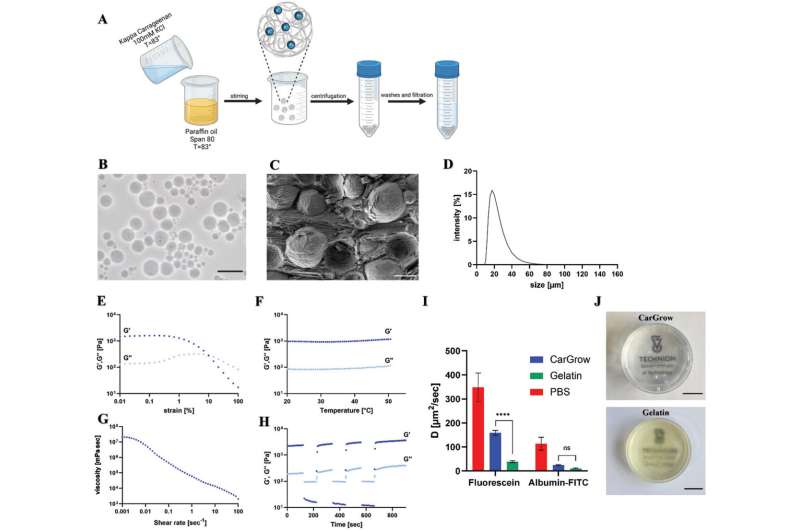New technology for growing printed tissues for transplantation

Researchers at the Technion–Israel Institute of Technology have developed an innovative technology for growing tissue for transplantation by printing it into a microgel bath as support material.
The research, published in Advanced Science, was led by Professor Shulamit Levenberg and her doctoral student Majd Machour from the Faculty of Biomedical Engineering along with Professor Havazelet Bianco-Peled and doctoral student Noy Hen from the Wolfson Faculty of Chemical Engineering and The Norman Seiden Multidisciplinary Graduate program in Nanoscience & Nanotechnology.
Tissue printing is an innovative approach for creating tissue for transplantation. In this technique, also called bio-printing, living cells are embedded in biological ink and printed layer upon layer. The printed tissue then undergoes growth for days or weeks until it is ready for printing.
Prof. Levenberg says, "Many research groups around the world are working on improving tissue printing, but most of them are focusing on the printing phase and the initial product—the printed tissue. However, the growth phase of the tissue—that is, the period between the printing and the transplantation in the target organ—is no less important.
"This is a complex period in which the printed cells divide, migrate, and secrete their extra cellular matrix and attach to each other to create the tissue. One of the problems is that in this complex process, the tissues tend to distort and shrink in an uncontrolled manner."
The Technion researchers thus focused on preventing the uneven shrinkage of the printed tissue in the weeks after printing. The solution was found through changing the medium in which the tissue is printed and grown.
The new concept, print-and-grow, is based on an original medium developed by the researchers—an innovative microgel used as a support material in the process, CarGrow, which is a substance mainly composed of carrageenan (Carrageenan-K) and is produced from red algae. In fact, the new support bath preserves the size of the tissue after printing and prevents it from shrinking and losing its shape.
This process allows reliable and controlled production of functional tissue in the desired size and shape. Since this material is transparent, it makes it possible for the scientists to monitor the development of the tissue through imaging.
The Technion researchers hope the new method will lead to the development of new technologies for bio-printing. The research was supported by an ERC (European Research Council) grant from the European Union.
About a year ago, Prof. Levenberg published another breakthrough in the field of bio-printing in Advanced Materials. In that study, she was able to create a printed tissue flap based on collagen and living cells containing major blood vessels and small blood vessels that feed the tissue and make possible a connection to the artery after the transplant. This allowed immediate blood flow into the engineered tissue right after the transplant, which accelerates and improves the integration of the tissue in the body.
More information: Majd Machour et al, Print‐and‐Grow within a Novel Support Material for 3D Bioprinting and Post‐Printing Tissue Growth, Advanced Science (2022). DOI: 10.1002/advs.202200882
Journal information: Advanced Materials , Advanced Science
Provided by Technion - Israel Institute of Technology





















